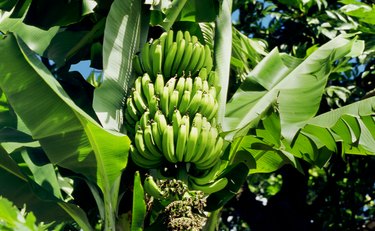
The world's tropical zones are closest to the equator, or the middle of Earth horizontally. These zones include parts of North and South America, Asia, Australia and Africa, making up 36 percent of the planet's land mass. The tropics get more sun exposure, so the seasons are different from everywhere else: There's a dry and wet season. This seasonal change in turn impacts the type of flora and fauna that thrive there, and the variety of food in tropic zones is well known. Some of the main ones are bananas, pineapples, coconuts, sugar cane, coffee, tea and cocoa.
What Is a Tropical Climate Zone?
Video of the Day
Tropical climate zones are hot and humid, with average temperatures above 64 degrees Fahrenheit throughout the year and 59 inches or more of precipitation. The wettest countries on Earth are Colombia, Sao Tome and Principe (Central Africa), Papua New Guinea, the Solomon Islands and Panama. Those who live in Colombia on its Pacific Ocean side experience rainfall practically every day.
Video of the Day
While there are many varieties of fruit species in the tropic zones, not many of them are used in local markets, and even fewer end up getting exported to other parts of the world. Along with bananas, pineapples and coconuts, the other big ones are mango, papaya and avocado. Lesser-known but familiar ones include acai, breadfruit, dragon fruit, figs, guava jack fruit, pomegranate, starfruit and tamarinds. Some even lesser-known foods that you might not have heard of include duku, langsat, feijo, rambutan, sapodilla and wax apples. These more exotic fruits manage to make their way into most of the world's major metropolitan cities.
Other Tropical Foods
While it's not easy to find a top 10 list of vegetables that grow in the tropics and many of these foods won't grow in the United States, some can grow easily in Hawaii. First are perennial collards, but these only go to seed in colder climates. You'd need seeds for fresh stock, but you can propagate them by cutting. Other tropical veggie plants include chayote, aji dulce sweet pepper, pole beans, chaya, Thai eggplant, bele, daikon, cherry tomatoes and pigeon peas.
Some experts advocate for diets rich in tropical foods with others that round out the offerings. These include root vegetables, like carrots, squash and sweet potatoes, and legumes, like beans, soybeans, lentils and chickpeas. For whole-grain diets based on tropical foods, you could include oats, brown rice, millet and quinoa. Fish is also a big part of tropical food diets, with the most notable ones being cod, salmon, sea bass, red snapper, haddock and sole. While many individuals in these parts do not consume meat as frequently, chicken and pork are still common.
Eating Tropical-Themed Meals
Tropical meals can be light and tasty if you do it right. One suggestion is to have some warm oatmeal or quinoa with fresh or thawed frozen banana, pineapple or mango. On top of this combination, you can add a bit of ginger, cinnamon and cocoa powder and top it off with some seeds and nuts. For the full effect, you can even start sipping on a big cup of Colombian coffee to wake yourself up.
If you're craving some cooked fish, you can try a recipe for grilled spiced snapper that sounds complicated but isn't as long as you have the right ingredients. It uses whole, head-on fish; Indian spices, like masala; a ripe, firm mango; red onion and lime juice. The fish gets grilled for about 10 minutes and is served with the other ingredients. Serve it with a glass of pomegranate juice and some coconut ice cream for dessert.